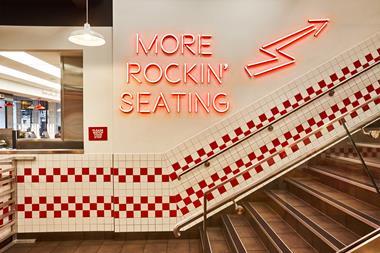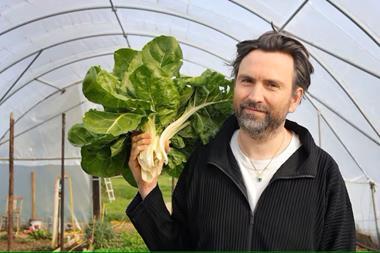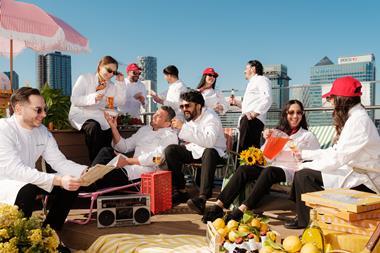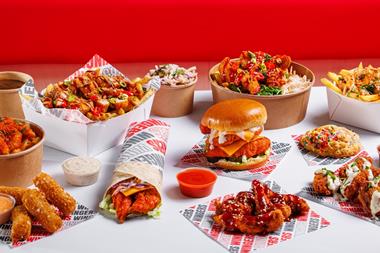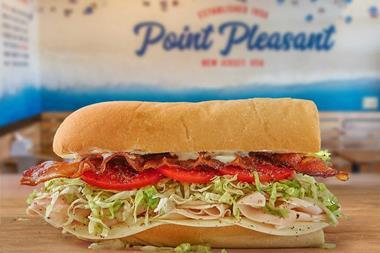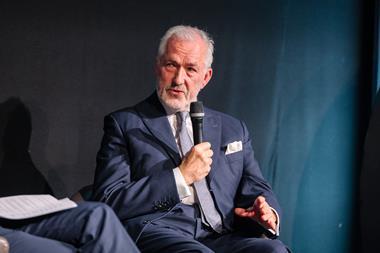Four and a half years ago, the US better burger brand Five Guys entered the UK market and hasn’t looked back since. Mark Wingett quizzes the company’s first UK employee and now brand development director Marcel Khan about the concept’s journey and what comes next.
“When people come for an interview with us we have this whole attitude of ‘you don’t want this job’,” explains Marcel Khan, brand development director at the fast-growing Five Guys UK. “We do that at crew level, management level and support level. It’s hardcore, it’s like the marines of fast food.”
Since becoming the company’s first UK employee in October 2012, through its launch in Covent Garden the next July and on to c80 sites here, plus openings in France, Spain and Germany, Khan has constantly been on the frontline as Five Guys has blazed a trail though the burger market. But he nearly didn’t get on the Sir Charles Dunstone-backed train.
“I was on the way out of Nando’s after 10 amazing years there (where he worked as regional managing director) and I wasn’t actively looking a for a new job,” Khan explains. “Then the call came in about Five Guys. I met John (Eckbert, UK chief executive), who headed up the project for Sir Charles and read up about the brand and the Murrell family (the founders). I was drawn to the whole American dream behind the ‘mom and pop’ business that took off without forgetting the values that made it a success in the first place. I was really interested and the more I got to know about the people behind the business, the more I liked it.
Everyone started talking about the burger wars, which we found kind of funny
“I got to go out to the US and the key thing for me was whether the burger was any good. At this point I had five conversations about taking the job and I was deep into it but of course the fear was, what if the burger is shit? It was a really tense moment when I had my first Five Guys burger, which was with my US counterpart Julie Speer, who has a good bullshit detector. Thankfully, I loved the burger and we started from there.”
Bun-dependence Day
That was October 2012 and the company, which operates over 1,000 sites in the US, opened its first UK site on 4 July in Covent Garden. A day later Shake Shack opened its first UK site, also in Covent Garden.
Khan says: “I don’t think I slept for 10 weeks around that time. We don’t spend any money on pro-active media, but Shake Shack do. So they put all the time and effort on making a big splash and media spend. Everyone then started talking about the burger wars, which we found kind of funny, especially as Danny Meyer (Shake Shack founder) spoke at one of our conferences and is friends with our founder Jerry Murrell. I think things have worked out well for both businesses since.”
Since then the biggest challenge has been keeping up with the pace of expansion and the company not losing focus. He says: “The challenge is not to veer away from what made us successful in the first place; focus on very few things, but do them well, and don’t drop the standards, while moving at a million miles an hour and pulling people into that train as you go. One of the biggest struggles we have is that we demand so much from people and we don’t always tee them up for that incredibly well. We tell them to get on the train because we love them and they say ‘wow this is moving a lot faster than we thought it would!’ It is hard work stoking this engine. It was the biggest struggle when we started and it is still the biggest struggle today.”
Even with that in mind, Khan says that retention levels are improving. “Month on month they are getting better and we are on target on where we want to be. Like everyone else, we have challenges with the labour market here in the UK, it is nervous days around this. But the reason I love this city, this industry and this business is the diversity that runs through it. We have got more resource and that has allowed us to make sure everyone is razor-sharp focused on their part of the business so we can produce the perfect burger, the perfect fries, spotless restaurants, fired-up crews etc.”
In terms of what hasn’t worked, Khan touches on the breakfast menu’s short trial, but the company hopes that the research and development on that day part, will eventually aid its entry into transport hubs.
Pushing standards higher
In terms of impact on the market and where the brand now sits, Khan is wary of lumping it in with a better burger segment that is currently going through a challenging period. He says: “I look at us in a very similar position to Nando’s. We care about our customer experience and our crew’s experience. You need to be pushing standards higher or you are going to be in trouble. We haven’t led that but we are part of that conversation. Without naming names or citing companies that are suffering, the majority have probably lost sight of that.”
There are swathes of the UK we haven’t gone to yet
The company has unsurprisingly thought about what the next five years will look like. Khan says: “We think the UK has a long runway including transport hubs, smaller footprint sites and a lot of city and town-centre locations that haven’t been explored yet. We think the opportunity in France is equal if not greater than that in the UK, if the initial reaction is anything to go on. It is similar in Spain. We have just opened our third site there and over performed our budget by a frightening amount. We then have Germany starting, and I would love to open in Scandinavia at some point. Everywhere we go, we open big, drop over the next three months and then settle at a good level.
“There are also swathes of the UK we haven’t gone to yet. At Nando’s we used to talk about what’s the ceiling? When we got to 50 we would ask do you think we could get to 100, then when we got there, we wondered about 150 and I am sure that conversation still takes place there. I don’t know where we are going to end up, the market decides. I don’t see us doing 250 units here but that’s my take, it may not be the view of the company. Next year’s pipeline is looking good and we would love to open 15-20 sites over the next 12 months. Over half of them have been secured.”
Making smaller sites work
Khan says that part of that on-going expansion will hopefully be helped by making a smaller format work. He says: “There are hard, set rules by the Murrell family on the design of a site, they are burger making machines. Part of it is how we build the sites and the quality of the kit. All the food is hand prepared for the day on the day, so to do that in smaller sites is tricky, but it would be good if we could figure it out.”
Average payback for a Five Guys site is approximately three and a half years. Khan says: “We also know now at what level of turnover we don’t work. We have no sites that lose cash, but we have sites that don’t perform as well as others. Our average unit volume is incredibly healthy and our like-for-likes are strong. There are always sites that would like to perform better financially, but we are more focused on getting them to perform better operationally. The overall picture is incredibly healthy.
“It has gone better than I expected here. No closures so far. We haven’t gone for any shortcuts in gaining fans. So much of what works well at Five Guys comes from what the Murrell family have always talked about – word of mouth. Just make sure everything is cool, don’t discount, don’t use cheap tactics to get people into the restaurants, we have never chased celebrity endorsements. We have never lost focus of that point.”





























